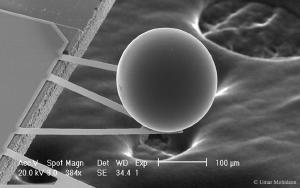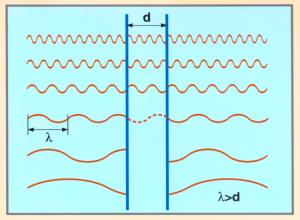Blog
Nothing But Net
6 March 2015
 Umar Mohideen
Umar MohideenYesterday I mentioned the Casimir effect, and how it could hypothetically be used to detect gravitons. But what exactly is the Casimir effect, and how do we know it’s real?
 Astronomy Cafe
Astronomy CafeThe Casimir effect is a great example the strangeness of quantum theory, and how even some of its strangest predictions turn out to be right. The effect was first proposed by Hendrik Casimir in the 1940s as a consequence of quantum fluctuations.1 The basic idea is that within quantum electrodynamics, a region of empty space actually contains quantum fluctuations of the electromagnetic field. These fluctuations are extraordinarily small, and in most cases we’d never notice them. But since they are electromagnetic, they are still affected by the presence of conducting materials. Specifically, they can be bounded by a conducting surface. So if you place two parallel conducting surfaces close to each other, the fluctuations are bound between the plates, but not outside the plates. As a result, there are less fluctuations between the plates than on either side. This means there is less pressure between the plates, and the plates are therefore pulled together.
This net attraction due to wave fluctuations is not particularly surprising. In fact you can demonstrate this effect with water waves. What makes is surprising is that according to classical electromagnetism, since the two plates are uncharged there should be no electric field between them and no force of attraction. Two plates in a vacuum are somehow attracted to each other simply because they are close together. When Casimir first calculated the effect, he used perfect “ideal” conductors. Later, more detailed calculations showed the effect for realistic conductors, and in 1997 the effect was confirmed experimentally. The most recent experiments get results to within 1% of the theoretical result. Strange as it is, the Casimir effect is very real.
Although the reality of the Casimir effect is not in doubt, its strangeness has led to much debate over what it actually means. Since it seems to show an extraction of energy from the “vacuum,” zero-point-energy fans have used it to support claims of “free energy” devices. Since the energy level between the plates is less than the average energy level outside the plates, the effect has been suggested as a solution for exotic physics such as wormholes and warp drive. It also raises difficulties in cosmology. If quantum fluctuations have real energy, then they should be affected by gravity, and that should affect the cosmological constant. According to QED the cosmological constant should be huge, but in fact it’s actually very small (assuming it’s the cause of dark energy).
But it’s important not to overstate the implications of the Casimir effect. It does raise some interesting questions about quantum gravity, but the main thing it does is demonstrate that our understanding of electromagnetism on a quantum scale is actually quite good.
Casimir, Hendrik BG, and Dirk Polder. “The influence of retardation on the London-van der Waals forces.” Physical Review 73.4 (1948): 360. ↩︎